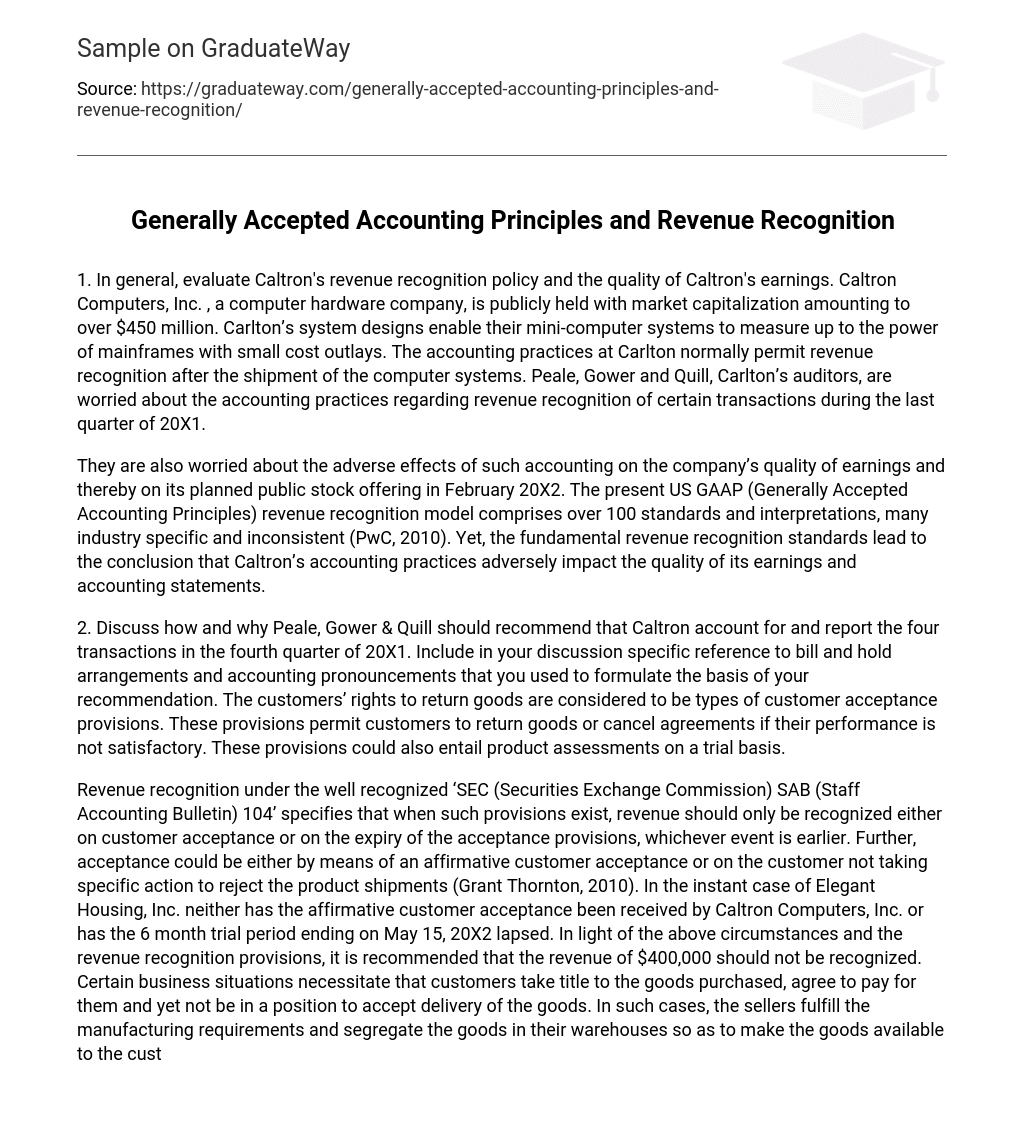1. Assess the revenue recognition policy and earnings quality of Caltron Computers, Inc., a publicly held computer hardware company with a market capitalization exceeding $450 million. Caltron’s mini-computer systems have impressive capabilities comparable to mainframes, yet at a lower cost. Typically, Caltron recognizes revenue after shipping the computer systems. However, Peale, Gower, and Quill, the auditors of Caltron, have concerns about the revenue recognition practices for specific transactions in Q4 of 20X1.
Concerns are also raised about the negative consequences of this accounting on the company’s earnings quality and its upcoming stock offering in February 20X2. The current revenue recognition model of US GAAP consists of more than 100 standards and interpretations, some of which are specific to certain industries and lack consistency (PwC, 2010). However, based on the fundamental revenue recognition standards, it can be concluded that Caltron’s accounting practices have a detrimental effect on the quality of its earnings and financial statements.
2. Peale, Gower & Quill should provide recommendations to Caltron regarding the accounting and reporting of four transactions that occurred in the fourth quarter of 20X1. The discussion should include the consideration of bill and hold arrangements and the accounting pronouncements utilized to formulate the recommendation. It is important to address the inclusion of customer acceptance provisions, which grant customers the right to return goods or cancel agreements in cases where the performance is deemed unsatisfactory. Additionally, these provisions may involve trial-based product assessments.
According to the SEC SAB 104, revenue should only be recognized when either customer acceptance occurs or when acceptance provisions expire, whichever happens first. Acceptance can be demonstrated by affirmative customer acceptance or by the customer not rejecting product shipments. In the case of Elegant Housing, Inc., neither affirmative customer acceptance from Caltron Computers, Inc. nor the expiration of the 6 month trial period on May 15, 20X2 has occurred. Based on these circumstances and revenue recognition rules, it is recommended that the $400,000 revenue should not be recognized. In certain situations, customers are obligated to take ownership and payment for goods but are unable to accept their delivery. In these cases, sellers meet manufacturing requirements and store the goods separately in warehouses so that customers can arrange for shipment. These transactions are known as ‘bill and hold’ agreements.
According to SAB 104, revenue recognition in cases of non-delivery of goods requires the fulfillment of several conditions. These conditions are: (1) the transfer of ownership risks to purchasers, (2) written commitments from customers to procure the goods, (3) the use of ‘bill and hold’ transactions requested by purchasers, (4) justification for such requests with significant business purposes, (5) fixed delivery schedules that align with purchasers’ business purposes, (6) no remaining performance obligations that indicate an incomplete earnings process for sellers, (7) isolation of goods solely for purchase agreements, and (8) finished products ready for shipment. The FASB’s ASC, issued in 2009, provides general guidance on assessing bill-and-hold agreements through Concepts Statement 5 and AICPA SOP 97-2.
The SEC has stated that US GAAP does not allow public companies to engage in bill-and-hold contracts without valid reasons for delaying the shipment of goods. In the case of the bill-and-hold agreement with Alation Electronics, there is no set delivery schedule and there is no clear business justification for postponing the shipment until the first quarter of 20X2, especially considering the lack of information regarding the consignee. Therefore, it is advised that the revenue of $250,000 should not be recognized.
According to the terms of the third transaction, which is the bill-and-hold arrangement with BTO Computer Leasing, there is no fixed delivery schedule even for the single identified user. Additionally, the other four end-users have not been identified yet. Once again, there doesn’t seem to be a valid business reason to request for holding the goods. Considering this, it is once again advised that the revenue of $950,000 should not be recognized. As mentioned in SAB 104, when customer acceptance terms are present, revenue can be recognized either upon buyer acceptance or upon the termination of acceptance terms, whichever occurs first.
According to the conditions specified in ‘ASC 605-15-25-1 to 25-4’, revenue can be recognized if a realistic estimate of returns is possible, provided that all other revenue recognition conditions are met. For a realistic estimation of product returns, an organization must have a significant number of homogeneous contracts. However, in the case of the transaction with Harvey Industries, customer acceptance has not been received and the 4-month trial period ending on March 27, 20X2 has not yet expired. Furthermore, there is insufficient historical data on similar contracts to make a realistic prediction of product returns. Therefore, it is recommended that the revenue amount of $110,000 should not be recognized.





